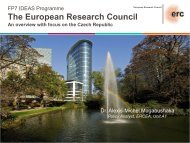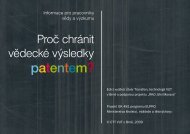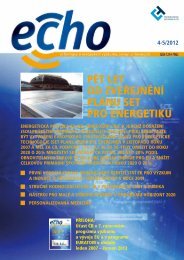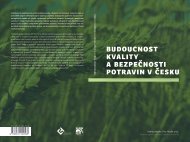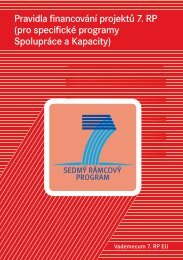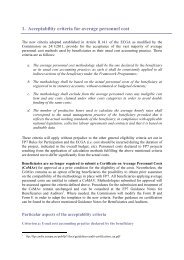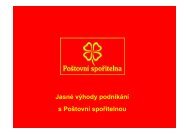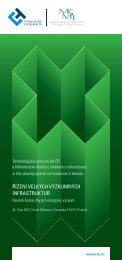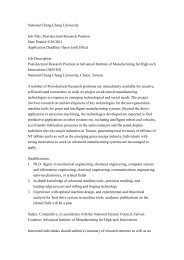Name, Surname
Name, Surname
Name, Surname
You also want an ePaper? Increase the reach of your titles
YUMPU automatically turns print PDFs into web optimized ePapers that Google loves.
taking into considerations also water requirements by industry, human consumption and the need to<br />
ensure a minimum environmental flow. Interaction is required between the JRC Integrated Water<br />
Modelling Platform, the JRC Land Use Modelling Platform, the Biophysical Model Applications platform<br />
(BioMA), the agricultural sector model CAPRI, the POLES energy model, and the regional climate modelling<br />
team. This interlinkage will allow capturing complex relations between biophysical processes and economic<br />
developments (e.g. prices, income, land use).<br />
• With the inclusion of 'greening' measures combined with the cross-compliance, the CAP represents an<br />
option to ensure that agricultural production uses natural resources in a sustainable way. Furthermore,<br />
biofuel policies may potentially impact production structure and land use having implication for farm<br />
practice adjustments, land use and overall markets developments. Agro-economic scenarios for the<br />
Danube Region will include aspects related to these policy developments and external factors and their<br />
relation to water allocation and water scarcity. A particular focus of the agro-economic analysis will be<br />
on productivity effects, market impacts, land use changes, development of incomes and their variation<br />
across regions and agricultural sectors. This work will be based on the use of the CAPRI model<br />
developed and maintained under the agro-economic modelling platform iMAP.<br />
• The changing allocation of water to and within agriculture can have impacts on agricultural production.<br />
Through bio-physical and crop modelling the impacts of a water supply modified in space and time as<br />
compared to today’s situation on cereals yield and production will be analysed and evaluated. Based on<br />
feedbacks from the second above-mentioned work package, this study will include the impact of<br />
changing irrigation water regimes (blue water) as well as changing patterns of precipitation as the<br />
natural water supply to agricultural plants (green water) due to climate change for chosen scenarios.<br />
• Regional climate scenarios will initially be those prepared for the PESETA-II study (Projection of<br />
Economic impacts of climate change in Sectors of the European Union based on boTtom-up Analysis).<br />
They are based on the work of all major regional climate modeling groups in Europe that collaborated<br />
in the FP6 ENSEMBLES project. The JRC has “bias-corrected” the output of the ENSEMBLES models, to<br />
make them useful for application in climate impact models. Near the end of 2013, new scenarios will<br />
become available in the international community and may be again bias-corrected by JRC. The use of<br />
consistent and up-to-date climate scenarios will be a strong element in the project.<br />
• The Land Use Modelling Platform (LUMP) which integrates sector-specific projections and plans (e.g. on<br />
macro-economy, agriculture, forestry, demography, transport) will provide results at a detailed<br />
geographical scale, taking full account of competing land use demands (for example for household,<br />
industrial settlements, etc.) and of spatial policy restrictions (e.g. Nature 2000 sites or other protection<br />
mechanisms). Bio-physical interactions between land, water, vegetation, are also considered. Specific<br />
scenarios of policy options (concerning e.g. regional development and cohesion) will be assessed and<br />
their impacts quantified, following selected environmental, social and economic criteria.<br />
• The energy model POLES has been extensively used in the context of mid- and long-term energy<br />
scenarios, under alternative assumptions and for different policy purposes related to the 20-20-20<br />
European initiatives amongst others. The model will be used to address the alternative patterns of<br />
exploitation of hydroelectricity in the countries of the Danube region in the scenarios addressed,<br />
depending on the water resource availability and the deployment of other power generation<br />
technologies.<br />
• The identification of the classes of water management options to be included in the scenario analysis is<br />
essential for the definition of the objectives to be evaluated in the multi-criteria decision. This<br />
assessment will use as boundary conditions the set of scenarios generated for the Danube region as<br />
identified in the previous bullets. Water management measures to be assessed will comprise e.g.<br />
improvement of the efficiency in the use of water (irrigation, energy, industrial uses), increase of water<br />
retention capacity through natural (floodplains, polders, wetlands) or technical infrastructure (dams,<br />
reservoirs), improvement of the quality of available water by changing farming practices, water transfer<br />
from one basin to another.<br />
EUROPEAN COMMISSION<br />
Joint Research Centre (JRC)<br />
6



